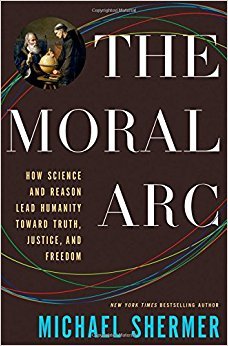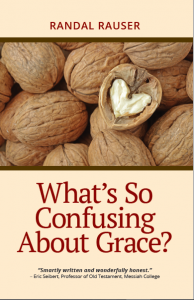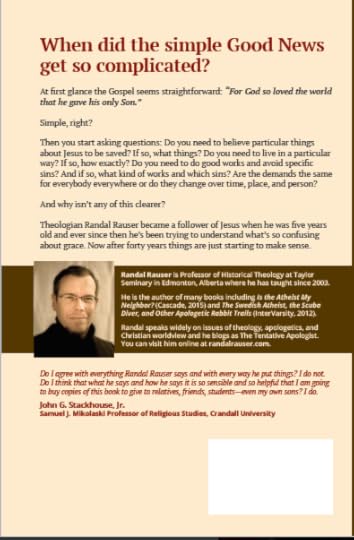Randal Rauser's Blog, page 120
July 28, 2017
A Review of The Moral Arc Part 3: From Absurdities to Atrocities
 For Part 2 of this review click here.
For Part 2 of this review click here.
Early on in The Moral Arc Michael Shermer quotes Voltaire: “Those who can make you believe absurdities, can make you commit atrocities.” (7) It’s clear that Shermer likes this quote because he returns to it on several occasions. At one point he offers a different translation: “Truly, whoever is able to make you absurd is able to make you unjust.” (105)
By contrast, Shermer’s secular gospel promises salvation from absurdities and the atrocities that they make possible: “One path (among many) to a more moral world is to get people to quit believing in absurdities.” (7) Here is Shermer’s secular Gospel laid bare:
“For tens of millennia moral regress best described our species, and hundreds of millions of people suffered as a result. But then something happened half a millennium ago. The Scientific Revolution led to the Age of Reason and the Enlightenment, and that changed everything.” (5)
But did it change everything? Does Shermer’s secular gospel really save us from absurdities and the atrocities they make possible?
Thank God Science for the Atom Bomb
In 1981 Paul Fussell wrote his famous essay “Thank God for the Atom Bomb” in which he justified the annihilation of 100,000 civilians in Hiroshima as a straight up calculation to minimize sentient suffering. Shermer isn’t interested in thanking God for the atom bomb, but he certainly will thank science.
And part and parcel with thanking science he offers an apologetic for the indiscriminate slaughter of 100,000 civilians:
“As to the morality of dropping the bombs, by the definition of morality in this book–the survival and flourishing of sentient beings–then not only did Fat Man and Little Boy end the war and stop the killings, they also saved lives, both Japanese and American. My father was possibly one such survivor.” (p. 72-3)
And if the actions ultimately reduced the carnage, they were morally justified. Shermer then proceeds to give us some numbers:
“Truman’s advisers estimated that between 250,000 and 1 million American lives would be lost in an invasion of Japan. […] By comparison (cold though it may sound), the body count from both atomic bombs–about 200,000 to 300,000 total (Hiroshima: 90,000 to 166,000 deaths, Nagasaki: 60,000 to 80,000 deaths) –was a bargain.” (73)
A bargain? Yup, that sounds cold all right.

Charred remains of a tricycle from Hiroshima.
Hiroshima at Ground Zero
In 1946 John Hersey published his bestselling book Hiroshima (New York: Knopf), a harrowing account of the bomb and its aftermath as told through the stories of six individuals. I have a valued first edition of the book and I thought we might be in a better place to consider Shermer’s moral reasoning if we considered Hiroshima from ground zero based on the reporting of Hiroshima.
Our first excerpt is drawn from the account of Dr. Sasaki:
“Before long, patients lay and crouched on the floors of the wards and the laboratories and all the other rooms, and in the corridors, and on the stairs, and in the front hall, and under the protecochere, and on the stone front steps, and in the driveway and courtyard, and for blocks each way in the streets outside. Wounded people supported maimed people; disfigured families leaned together. Many people were vomiting. A tremendous number of school girls–some of those who had been taken from their classrooms to work outdoors, clearing fire lanes-crept into the hospital. In a city of two hundred and forty-five thousand, nearly a hundred thousand people had been killed or doomed at one blow; a hundred thousand more were hurt.” (34-5)
And then there are the haunting recollections of Mr. Tanimoto:
“he met hundreds and hundreds who were fleeing, and every one of them seemed to be hurt in some way. The eyebrows of some were burned off and skin hung from their faces and hands. Others, because of pain, held their arms up as if carrying something in both hands. Some were vomiting as they walked. Many were naked or in shreds of clothing. On some undressed bodies, the burns had made patterns–of undershirt straps and suspenders and, on the skin of some women (since white repelled the heat from the bomb and dark clothes absorbed it and conducted it to the skin), the shapes of flowers they had had on their kimonos.” (39-40)
And now for the experience of Miss Sasaki:
“Miss Sasaki could not move, and she just waited in the rain. Then a man propped up a large sheet of corrugated iron as a kind of lean-to, and took her in his arms and carried her to it. She was grateful until he brought to horribly wounded people–a woman with a whole breast sheared off and a man whose face was all raw from a burn–to share the simple shed with her. No one came back.” (44)
At this point we can return to the hellish account of Mr. Tanimoto:
“Mr. Tanimoto found about twenty men and women on the sandspit. He drove the boat onto the bank and urged them to get aboard. They did not move and he realized that they were too weak to lift themselves. He reached down and took a woman by the hands, but her skin slipped off in huge, glove-like pieces.” (60)
And finally we turn to the nightmarish experience of a priest, Father Kleinsorge, who encountered the living dead gathered in a park:
“On his way back with the water, he got lost on a detour around a fallen tree, and as he looked for his way through the woods, he heard a voice ask from the underbush, ‘Have you anything to drink?’ He saw a uniform. Thinking there was just one soldier, he approached with the water. When he had penetrated the bushes, he saw there were about twenty men, and they were all in exactly the same nightmarish state: their faces were wholly burned, their eyesockets were hollow, the fluid from their melted eyes had run down their cheeks.” (68)
Conclusion
No doubt Michael Shermer assumes that he doesn’t believe any absurdities. He only believes in reason and evidence. His secular gospel and its utilitarian ethic are, in his view, perfectly rational calculations speeding us toward the moral arc of history. The religiously motivated torture and execution of suspected witches, he abhors. By contrast, the eradication of tens of thousands of civilians in the name of geopolitics and utilitarian ethics are perfectly reasonable steps on the long moral arc.
The irony is that through it all Volatire’s dictum just may be vindicated. After all, Shermer’s view of reality strikes me as perfectly absurd.
The post A Review of The Moral Arc Part 3: From Absurdities to Atrocities appeared first on Randal Rauser.
The Kindle Version of What’s So Confusing About Grace? is Now Available
Wow, my shortest post ever. Please see the title for more information.
The post The Kindle Version of What’s So Confusing About Grace? is Now Available appeared first on Randal Rauser.
July 27, 2017
The First Review for What’s So Confusing About Grace?
One of the regular readers of my blog, David, just posted the first review of What’s So Confusing About Grace? at Amazon.com. It’s a very fine review and you can read it here. So read the review and then get the book that everyone David is talking about! 
July 26, 2017
Two Days of Right Wing Talk Radio and I’m Depressed

Montana is so conservative even the Honda Civics have “Hillary for Prison” bumper stickers.
I just got back from a visit with family in Colorado. So how do you pass the time during a three day drive home? Simple: American talk radio: Rush Limbaugh, Sean Hannity, Michael Savage, Michael Medved. All told I digested about ten hours of populist, right wing analysis.
Wow, is that depressing: incessant staccato chatter about the “Deep State” and Clinton’s alleged conspiracy with the Ukranians, indignant harangues against the “moral bankruptcy” of the Democrats and the “lamestream media,” fear mongering of immigrants who “refuse to assimilate”, rage against “lazy” people who would rather collect welfare than work.
But the Palme d’Or goes to Michael Savage who angrily denounced critics of Trump’s crass Boy Scout speech as “left-wing vermin”.
That’s right, vermin.
Two days of right wing talk radio.
No wonder I’m feeling depressed.
The post Two Days of Right Wing Talk Radio and I’m Depressed appeared first on Randal Rauser.
July 25, 2017
My New Book is now Available in Canada
 My new book What’s So Confusing About Grace? is now available to order at Amazon.ca. What is more, the Look Inside feature on Amazon is now activated so you can check out the beginning of the book.
My new book What’s So Confusing About Grace? is now available to order at Amazon.ca. What is more, the Look Inside feature on Amazon is now activated so you can check out the beginning of the book.
The Kindle version should be available in a couple weeks.
I’ve written eleven books now and I’ve never had more fun writing a book than this. Here it is, my personal story of coming to understand the Gospel, the good, the bad, and the ugly.
If you’ve benefited from this blog, please consider supporting my work by purchasing a copy of the book and spreading the word.

The post My New Book is now Available in Canada appeared first on Randal Rauser.
July 24, 2017
What’s So Confusing About Grace? The Endorsements
Do I agree with everything Randal Rauser says and with every way he put things? I do not. Do I think that what he says and how he says it is so sensible and so helpful that I am going to buy copies of this book to give to relatives, friends, students—even my own sons? I do.
John G. Stackhouse, Jr., Samuel J. Mikolaski Professor of Religious Studies, Crandall University
We need more books like this! In a style both engaging and accessible, Randal Rauser graciously invites us to reexamine some of our most basic Christian beliefs. Drawing upon key questions, crises, and revelations from his spiritual journey, Rauser creates the much needed space to help readers reflect on their own. Smartly written and wonderfully honest, this book will deepen your faith and increase your love for God. Highly recommended!
Eric Seibert, Professor of Old Testament, Messiah College
I was prepared to hear the tale of Randal Rauser’s theological journey from angsty certitudes to 50 shades of complex faith. What I didn’t reckon on was that he’d been in my own head and outed my particular spiritual trek. That made for a sometimes-perturbing, sometimes-hilarious walk down and back out of memory lane, reaffirming the Spirit’s guidance and grace thus far. It’s also daunting knowing this Gospel we pursue might yet double-down on what’s been revealed and expected so far. But less so knowing that we’ll walk the Way with companions like Dr. Rauser, whose retrospective wisdom invites me from dourness to mirth. Much appreciated!
Brad Jersak, PhD, author of A More Christlike God
The post What’s So Confusing About Grace? The Endorsements appeared first on Randal Rauser.
July 21, 2017
Launching My New Website ConfusedAboutGrace.Com
I have launched a new website to complement my book What’s So Confusing About Grace? Titled confusedaboutgrace.com it features some information on the book including a downloadable 10 page excerpt.
The new website also includes a blog in which I will be posting some reflections to accompany the book. My first entry to the blog is now available as well, and it’s appropriately titled “What’s So Confusing About Grace?“
The post Launching My New Website ConfusedAboutGrace.Com appeared first on Randal Rauser.
July 20, 2017
What’s So Confusing About Grace? My New Book has Arrived!
Well, it’s mostly arrived. Print copies are now available to order on Amazon.com. The Kindle version will be available in a week or so. And it should be available at Amazon.ca not long after that. This is the most personal book I’ve ever written, three hundred pages chronicling my forty year theological journey in attempting to understand God’s grace. So check out the book and spread the word.
The post What’s So Confusing About Grace? My New Book has Arrived! appeared first on Randal Rauser.
A Review of The Moral Arc Part 2: Reason as Rhetoric
 For Part 1 of this review click here.
For Part 1 of this review click here.
Imagine that you’re over at your friend Mike’s house for dinner when he pulls out a Monopoly box and invites you to a game. “But before we get started,” he says, “the rules are that I get $500 every time I pass go and you don’t get anything. ”
You protest: “That’s not fair. You’re setting up the game so you can’t lose!”
Mike is unmoved. “This is my house, my Monopoly game, and my rules,” he says. “If you don’t like it, then don’t play.”
The Moral Arc features a competition of sorts: on the one side we have religion (generally) and Christianity (specifically), and on the other side we have Shermer’s own secular worldview which he refers to variously as “scientific naturalism” or “a naturalistic, science-and reason-based worldview.” (114)
That latter description should be a tip-off that this isn’t a fair match: Shermer is setting up the game with his own version of Mike’s Rules according to which science and reason favor his worldview while the other guys — the religious and Christian folk — can only lay claim to “magic” and “superstition.” With that set up, it’s pretty clear who is going to win this game: this is Mike’s book and his rules, and if we don’t like it then we don’t have to read.
Science, Empirical Reason, and Naturalism
Shermer sets up the argument in the following passage in which he states his thesis of the arc of moral progress while claiming that it is primarily attributable to “secular not religious forces” including “science and [empirical] reason”:
“we can trace the moral arc through science with data from many different lines of inquiry, all of which demonstrate that in general, as a species, we are becoming increasingly moral. As well, I argue that most of the moral development of the past several centuries has been the result of secular not religious forces, and that the most important of these that emerged from the Age of Reason and the Enlightenment are science and reason, terms that I use in the broadest sense to mean reasoning through a series of arguments and then confirming that the conclusions are true through empirical verification.” (3)
Did you catch that? Shermer defines the process of reasoning and appealing to empirical evidence to support arguments as an example of a “secular force”. Talk about gaming the system: by that definition if Michael Behe had succeeded in establishing that the bacterial flagellum was irreducibly complex he would have only provided ammunition for “secular not religious forces”.
Remember Monopoly: when I pass go I get $500. And you get nothing…
Shermer nowhere explains precisely what it takes for a “force” to be religious rather than secular. Nor does he explain why we should assume these are exclusive categories. However, he does appear to assume that forces (i.e. beliefs and actions that impact the world) which originate in empirical verification (i) properly count as secular rather than religious and (ii) thereby favor a naturalistic worldview.
Speaking of “naturalistic worldview”, Shermer invokes the term “scientific naturalism” a handful of times. The term appears to refer to the worldview he is defending over-against Christianity, religion, and supernaturalism. However, he never defines “scientific naturalism.” This is a massive lacuna in the argument since the term “naturalism” is one of the most controversial and tortured terms in contemporary philosophy. Needless to say, it is well-nigh impossible to assess whether evidence supports Shermer’s worldview if he never defines that worldview.
To make matters worse, Shermer also never defines “religion”. This is also very problematic since “religion” is a highly contested, abstract concept. (Is communism a religion? What about consumerism? Or humanism? Naturalism? And who decides?) He also never defines supernaturalism or Christianity (though I’m okay with an ostensive definition of Christianity).
As a result, we are left very much in the dark as to what exactly Shermer is defending or how the evidence he proffers is supposed to support it.
The Witch Theory of Causality
To consider a concrete example we can turn to Shermer’s discussion of the “witch theory of causality.” In the narrow sense, this phrase functions to identify the theory that witches exist and some (negative) effects in the world can be attributed to their nefarious action. Shermer also observes that in a broader sense, the phrase functions as “a catchall explanation for the miseries of life” (114).
For the most part, Shermer appears to use the term in that broader sense. Unfortunately, it isn’t at all clear what that means. Time and again, Shermer cannot be bothered to move beyond nebulous rhetoric in his definition and use of terms. For someone who touts “reason”, he indulges in a surprising amount of polemic.
When it comes to the witch theory of causality and its eventual abandonment, Shermer writes:
“The primary difference between these premodern people and us is, in a word, science. Frankly, they often had not even the slightest clue what they were doing, operating as they were in an information vacuum, and they had no systematic method to determine the correct course of action either. The witch theory of causality, and how it was debunked through science, encapsulates the larger trend in the improvement of humanity through the centuries by the gradual replacement of religious supernaturalism with scientific naturalism.” (105)
Witch trials have long achieved a sort of mythic status among secularists angling to critique the damage wrought by “religion” and so it is no surprise that they make an appearance in The Moral Arc.
Shermer’s recounting of the historical abandonment of witch interrogation and trials nicely illustrates how he tendentiously games the system to favor his undefined worldview. He tells the story of two Jesuits who believed in the use of torture to elicit confessions from witches.
The Duke of Brunswick, however, suspected that women were confessing falsely under duress simply in an attempt to avoid further torture. So he brought these two Jesuits into the dungeon to witness the torture of a suspected witch. Then while she was being tortured, the Duke asked her if the two Jesuits observing the proceedings were involved in witchcraft. In response, she dutifully agreed and then she went on to accuse the two men of a litany of horrific crimes. (112)
Of course, the Jesuits knew they were innocent of such absurd charges. As a result, they experienced a Eureka moment as they recognized that confessions elicited under torture were unreliable. From that point on they began to speak out against the practice and soon the Archbishop of Menz abolished the use of torture altogether.
All parties to the discussion can agree heartily that this is a fine example of reason and evidence winning out over errant beliefs and practices. The problem is that Shermer also aims to claim this case for scientific naturalism over-against Christianity, religion, and supernaturalism. Remember, according to Shermer the fact that these men reasoned informed by empirical evidence entails that they were moved by “secular” rather than “religious” forces.
Mike’s rules strike again: I get $500 and you get nothing.
Of course, this is all incredibly tendentious. And as I said, with no formal definitions for “scientific naturalism” or “religion”/”supernaturalism” it is exceedingly difficult to see how this case of good reasoning really supports naturalism. The fact is that by any plausible measure it seems to me that a case like this completely underdetermines the competing philosophies/worldviews and thus provides direct evidence for none of them.
What it does provide is evidence for the importance of good reasoning. Unfortunately, when it comes to the overarching argument of The Moral Arc, that is a commodity in short supply.
The post A Review of The Moral Arc Part 2: Reason as Rhetoric appeared first on Randal Rauser.
July 18, 2017
This is how strange a free market approach to healthcare looks to a Canadian like me
Imagine a world in which all citizens were not extended protection by the police. Instead, the government aimed to offer people various tax credits and incentives to buy police protection from private security firms. And as a result, some people were protected by powerful armed militias, others had spotty protection from ill-equipped security guards, and still others were left to fend for themselves as in The Purge.
Crazy, right?
That’s how the Republican free market approach to healthcare looks to a Canadian like me.
The post This is how strange a free market approach to healthcare looks to a Canadian like me appeared first on Randal Rauser.






